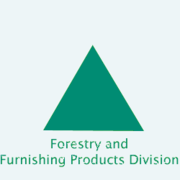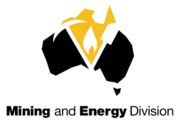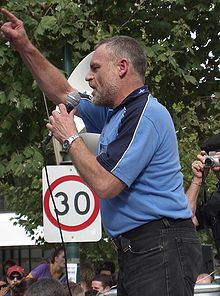- Construction, Forestry, Mining and Energy Union
-
CFMEU 
Full name Construction, Forestry, Mining and Energy Union Founded 1992 Members 120,000 Country Australia Affiliation ACTU, ALP Key people Michael O'Connor (National Secretary), Tony Maher (National President) Dave Noonan (Assistant National Secretary). Website www.cfmeu.net.au The Construction, Forestry, Mining and Energy Union (CFMEU) is Australia's main trade union in construction, forestry and furnishing products, mining and energy production.
The CFMEU has offices in all capital cities in Australia and in many major regional centres with the national office of the union in Sydney. The union has an estimated 120,000 members and employs around 400 full time staff and officials.
Contents
Divisions
The CFMEU is structured into three main divisions being the Construction and General Division, the Mining and Energy Division and the Forestry and Furnishing Products Division. Each division operates largely autonomously although there is some crossover of coverage.
Construction and General Division
History
The Construction and General Division was formed in the early 1990s with the creation of the national CFMEU. This was part of the ACTU inspired union rationalisation process. The creation of a single building union had been a policy objective of various building unions for decades with records showing the Queensland Branch of the Operative Painters and Decorators Union (OPDU) carried resolutions calling for a single industry union to be created as early as the 1920s. The rationale behind this policy position was the logical view that members would be better represented by a larger industry based union rather than the traditional craft unions.
The largest amalgamating union, the Building Workers Industrial Union (BWIU) was itself the result of numerous amalgamations over several decades between 1946 and 1992. The coverage of the BWIU included numerous craft unions representing building tradespeople including bricklayers, carpenters, plasterers, tilers, stonemasons and various skilled non-trades construction workers. In the late 1980s the BWIU increased its coverage to include other construction workers such as steel fixers, concreters, construction labourers and trades assistants following the deregistration of the Builders Labourers Federation (BLF).
The division also has members working off-site in manufacturing workplaces such as shopfitting workshops, joinery shops and other establishments involved in the pre-fabrication of materials used in the construction process. Members also work in brick, tile and pottery manufacturing and in Queensland, the union covers furnishing trades as there is no formal Forestry Division in the State, due to the Australian Workers Unions historical coverage of this industry. The Queensland Branch does, however have a presence in Queensland's forestry sector with CFMEU members employed by the State Government working for the Department of Primary Industries.
With the absorption of the Federated Engine Drivers and Firemens Association of Australasia (FEDFA) which had coverage of crane drivers, plant operators, and other construction workers, the Construction and General Division has moved closer to fulfilling the policy objective of creating a single industry union for construction workers.
Political Activity
The Construction Division is often associated with the left faction of the Australian labour movement however during the 2010 Federal election substantial funds were discreetly handed over to the Greens which has outraged many financial members and led to resignations en masse.
The division also has coverage battles for membership of employees with the Australian Workers Union (AWU) over civil construction projects, as both unions' rules allow them to cover civil construction (e.g. roads, bridges, dams etc.). This has led to several demarcation disputes. Employers sometimes negotiate with both the AWU and CFMEU for the best deal.
Each State division operates with autonomy which results in differing services being offered to the members.
The NSW Branch of the CFMEU General and Construction Division has an estimated 11,000 members and the Victorian Branch around 15000.
In August 2010, the CFMEU donated $1.2 million to political activist group GetUp! to pay for TV airtime for a women's rights ad-spot condemning Tony Abbott and the Liberal Party.[1]
Forestry and Furnishing Products Division
The CFMEU Forestry and Furnishing Products Division was first registered as a Federal Organisation the 21 August 1907, as the Federated Sawmill, Timber-yard and Woodworkers Employees Association of Australasia.
The Union's name was changed in 1913 to the Amalgamated Timber Workers Union of Australia, and again in 1918 to the Australian Timber Workers Union.
In late 1990 a ballot was conducted by members of the Australian Timber Workers Union and the Pulp and Paper Workers Federation of Australia endorsing the amalgamation of both Unions to form the Australian Timber and Allied Industries Union.
Another ballot was conducted in mid 1991 on the amalgamation between the Australian Timber and Allied Industries Union and the Building Workers Industrial Union. This endorsement supported the first stage in the development of what is now the Construction, Forestry, Mining and Energy Union. The Forest and Furnishing Products Division represents 20,000 members nationally.
Mining and Energy Division
The Mining and Energy Division consists of a number of unions which have amalgamated. The largest union to contribute to the formation of the division was the Miners’ Federation which was previously the Australasian Coal and Shale Employees’ Federation (ACSEF) which had a continuous history dating back to 1915. Predecessors to the ACSEF had existed on and off since the 1850s.
Industries covered by the Mining and Energy Division include the coal industry, coal ports, the metalliferous mining industry, electric power generation, oil and gas and the small coke industry.
- The Coal Industry: The coal industry is the majority of the Mining and Energy Divisions' coverage. Of more than 16,500 members around 13,000 work in the coal industry. The CFMEU is the primary union for the coal mining industry.
- Coal Ports: The union represents most workers (approximately 500) at export coal ports located along the east coast of Australia
- Metalliferous Mining: The Division covers most metalliferous miners in Broken Hill where silver, lead and zinc ores are mined. There are around 400 members at Broken Hill. Other mines are largely covered by the AWU. Through the amalgamation with the FEDFA, the division also has around 1,500 members at metalliferous mines in Western Australia, South Australia, Tasmania and Queensland.
- Oil, gas and electricity: The division has around 2,200 members employed in power stations, oil refineries and other parts of the oil and gas production chain. This division is the major union representing workers in the Victorian power generation industry.
- The Coke Industry: This industry as a stand-alone commercial industry is quite small in Australia. Most coke production is tied to iron and steel operations. There are stand-alone coke works on the South Coast of NSW (north of Wollongong) and in Bowen in Northern Queensland.
- The Mining and Energy Division covers the cokeworks on the south coast and the AWU covers the Bowen site. The CFMEU has approximately 50 members in the coke industry.
Recent events
Internal Divisions
In recent years there has been some tension between the Forestry and Furnishing Products Division and the rest of the union particularly in regard to the Division's hostile attitiude to the Australian Labor Party in the 2004 Federal Election over the Federal ALP's policy on logging in Tasmania. Scenes of loggers openly cheering and congratulating John Howard were seen as treachery by the other divisions.
Relationship with the Howard Government
In 2001 the Howard Government initiated the Royal Commission into the Building and Construction Industry (commonly known as the Cole Royal Commission). The Commission and its findings were largely condemned by the ALP and the Greens which argued that the terms of reference were too narrow. The CFMEU asserted that the purpose of the Commission was a "witch-hunt" to reduce the power of the CFMEU rather than to investigate crime. [1]
The CFMEU General and Construction division rooted out some corruption within the union.[2]
Terence Cole found 392 cases of unlawful conduct. 98 of these were passed on to prosecution authorities by the Commonwealth attorney-general. Of these, just 26 were considered breaches of criminal law.
By early February 2006, 95 of the 98 cases had been resolved without legal action and the outcome of the remaining three has never been disclosed or explained.
One union organiser was also jailed for contempt of court.[3]
As a result of the Commission's findings the Australian Building and Construction Commission (ABCC) was established. It has a wide range of coercive powers, including forcing people to answer questions under oath. Penalties of up to $22,000 for individuals and $110,000 for corporations and unions apply for breaches of the Building and Construction Industry Improvement Act 2005.
Under WorkChoices, situations where industrial action could take place were reduced, making industrial action about safety concerns difficult. The onus of proof was reversed. The CFMEU and workers had to prove a workplace was unsafe in order to put a stop to work on a site. Construction workers, unions and employers face fines four times higher than other sectors for actions deemed illegal.
References
- ^ http://www.getup.org.au/about/disclosure/ accessed 21 Nov 2010
External links
- Official website
- Construction and General Division Official website
- Australian Council of Trade Unions
- Australian Trade Union Archives entry
- CFMEU Queensland Branch
- CFMEU Western Australia Branch
- CFMEU NSW Branch
- ABCC
See also
Categories:- Australian labour movement
- Trade unions in Australia
- Energy in Australia
Wikimedia Foundation. 2010.



